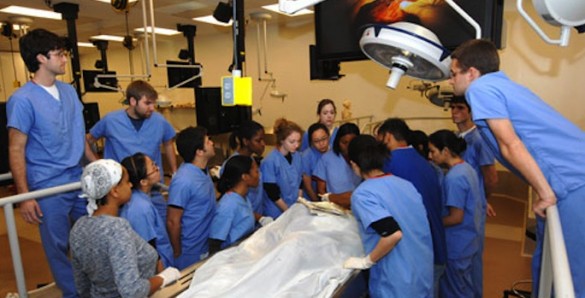Vanderbilt University School of Medicine (VUSM) now ranks No. 8 in the nation among U.S. medical schools in total grant support provided through the National Institutes of Health (NIH). The new ranking raises VUSM’s standing two spots from the No. 10 position it held last year.
Receiving $340,049,796 in total NIH grant support during calendar year 2016, VUSM finished the year with an additional $48,854,269 in funding over its 2015 total.
Support from the NIH for research continues to be increasingly competitive among the nation’s leading academic medical centers and remains a key indicator of an institution’s overall strength in biomedical research.
NIH funding provides crucial support for Vanderbilt’s researchers to advance the understanding of the underlying causes of and to develop new treatments for a diverse array of adult and childhood diseases and disorders that cost the U.S. economy more than $3 trillion each year.
Last year was historic in terms of VUSM’s receipt of competitively funded research support, including the largest single grant in Vanderbilt history — a $71.6 million, five-year award to support the Data Research and Support Center for the NIH’s Precision Medicine Initiative Cohort Program, now called the All of Us Research Program.
“This increase is the result of the relentless competitiveness of our faculty and reflects the high standards to which they hold themselves regarding the quality and integrity of their research. We are grateful to the NIH for the trust it places in Vanderbilt. Moving up two spots in overall funding is an enormous achievement and I want to congratulate everyone for this success,” said Jeff Balser, M.D., Ph.D., President and CEO of VUMC and Dean of VUSM.
“While the NIH continues to face a significant threat to its overall funding through recent proposals that would impact the federal budget, our faculty continue to make groundbreaking discoveries here each and every day.”
This year, four basic science research departments and six clinical departments are ranked among the nation’s top 10 in NIH funding relative to similar departments at peer institutions.
“NIH funding supports discovery across our campus. With this essential support, School of Medicine researchers join with their colleagues from the School of Engineering, the College of Arts and Science, Peabody College and the School of Nursing to bring their varied expertise to bear on society’s most pressing questions,” Provost and Vice Chancellor for Academic Affairs Susan Wente, Ph.D., said. “We believe the answers to those questions lie at the intersection of disciplines, and we greatly appreciate the NIH’s recognition of and investment in the University’s vision for trans-institutional research.”
Among VUSM’s basic science departments, Biochemistry ranks third; Cell and Developmental Biology, first; Molecular Physiology & Biophysics, third; and Pharmacology, sixth. Six clinical departments ranked among the top 10, including: Internal Medicine, third; Ophthalmology, ninth; Otolaryngology and Hearing & Speech Sciences, sixth; Pediatrics, fourth; Radiology & Radiologic Sciences, eighth; and Surgery, eighth.
“Our faculty have a long history of leadership in biomedical science and they are continuing their exciting, world-class research,” said Lawrence Marnett, Ph.D., University Professor of Biochemistry, Chemistry and Pharmacology, Mary Geddes Stahlman Professor of Cancer Research and dean of the basic sciences in the School of Medicine. “Their ability to compete for NIH funding in a very challenging environment is impressive and will enable them to continue making fundamental advances in our understanding of complex biological systems. The seamless transition between our basic and clinical departments ensures that these new discoveries will be translated into improving human health.”
Each institution’s funding data are compiled by the independent Blue Ridge Institute for Medical Research from figures available through the 2016 award files obtained from the Research Portfolio Online Reporting Tool (RePORT) from the NIH.
Figures include direct plus indirect costs but exclude research contracts and ARRA (stimulus) grants.
The National Institutes of Health is the world’s largest funding source for biomedical research. More than 80 percent of the NIH’s budget goes to support extramural funding for 325,000 research personnel at more than 3,000 universities and research institutions.
To learn more about the Strategic Directions, go here.















